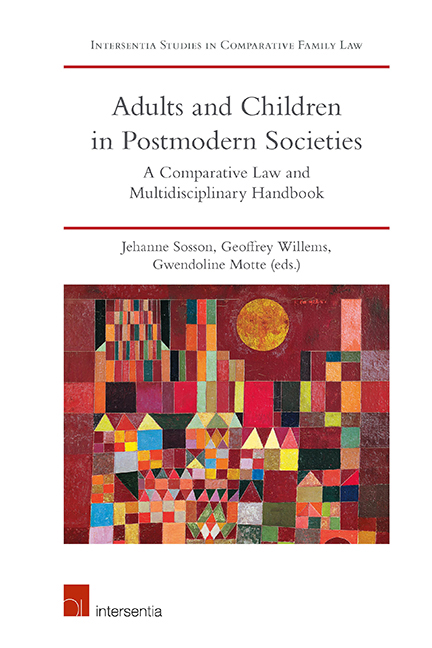Book contents
- Frontmatter
- Contents
- List of Cases
- List of Contributors
- Introduction
- PART I NATIONAL REPORTS ON LEGAL REGULATIONS OF RELATIONSHIPS BETWEEN ADULTS AND CHILDREN
- Questionnaire
- Models
- Algeria
- Argentina
- Australia
- Belgium
- Canada
- Democratic Republic of the Congo
- England and Wales
- France
- Germany
- Ireland
- Italy
- Japan
- The Netherlands
- Romania
- Spain and Catalonia
- Sweden
- Switzerland
- United States of America
- PART II INTERDISCIPLINARY APPROACH
- PART III INTERNATIONAL LAW INSIGHTS
- PART IV COMPARATIVE APPROACH
- General Conclusion: The Challenge of Transparent and Inclusive Parenthood/Parentality in a Pluralist and Cosmopolitan Context
- About the Editors
United States of America
from PART I - NATIONAL REPORTS ON LEGAL REGULATIONS OF RELATIONSHIPS BETWEEN ADULTS AND CHILDREN
Published online by Cambridge University Press: 26 June 2019
- Frontmatter
- Contents
- List of Cases
- List of Contributors
- Introduction
- PART I NATIONAL REPORTS ON LEGAL REGULATIONS OF RELATIONSHIPS BETWEEN ADULTS AND CHILDREN
- Questionnaire
- Models
- Algeria
- Argentina
- Australia
- Belgium
- Canada
- Democratic Republic of the Congo
- England and Wales
- France
- Germany
- Ireland
- Italy
- Japan
- The Netherlands
- Romania
- Spain and Catalonia
- Sweden
- Switzerland
- United States of America
- PART II INTERDISCIPLINARY APPROACH
- PART III INTERNATIONAL LAW INSIGHTS
- PART IV COMPARATIVE APPROACH
- General Conclusion: The Challenge of Transparent and Inclusive Parenthood/Parentality in a Pluralist and Cosmopolitan Context
- About the Editors
Summary
The United States is comprised of 50 states within a federal constitutional system. Federal law takes precedence over state law, and all laws must comport with the US Constitution. The US Supreme Court is the highest court in the land, so its rulings bind all lower courts. However, the Supreme Court hears only cases raising a federal or constitutional question, so matters solely of state law are decided by each state's court system. State judicial systems consist of trial courts, intermediate appellate courts, and state supreme courts. The US Constitution imposes limits on the states ‘regulation of the family that have shaped the law governing parents and children in significant ways. But the laws governing parents and children are for the most part state laws that vary from one jurisdiction to another. Family law is heavily statutory, with court decisions interpreting and applying those statutes.
In responding to the survey, I have provided an overview of the approaches taken by the states, but the answers below do not attempt to capture all the specific variations that exist among the 50 states on many of these questions.
CHANGES IN THE TRADITIONAL FAMILY
A. MOTHERS
1. Is maternity automatically established by the birth certificate?
Yes generally. Birth certificates typically require identification of the mother.
However, in some jurisdictions, two men who have a child through surrogacy may obtain a pre-birth parentage order naming both of them as parents. These orders allow both fathers’ names to appear on the birth certificate, instead of a mother and a father, so no maternity would be established. In addition, in some surrogacy situations, the mother identified on the initial birth certificate does not remain the child's legal mother. In states that require the intended parents to obtain a post-birth parentage order, the birth certificate is amended to identify the intended mother or second father, rather than the surrogate, as the child's parent. Birth certificates are also amended when a child is adopted. Some jurisdictions have now changed their birth certificate forms to use nonheteronormative language, leaving space for identification of mother/father/ parent, rather than ‘mother’ and ‘father’ (see also Q. 18 and 27).
- Type
- Chapter
- Information
- Adults and Children in Postmodern SocietiesA Comparative Law and Multidisciplinary Handbook, pp. 583 - 622Publisher: IntersentiaPrint publication year: 2019
- 1
- Cited by



